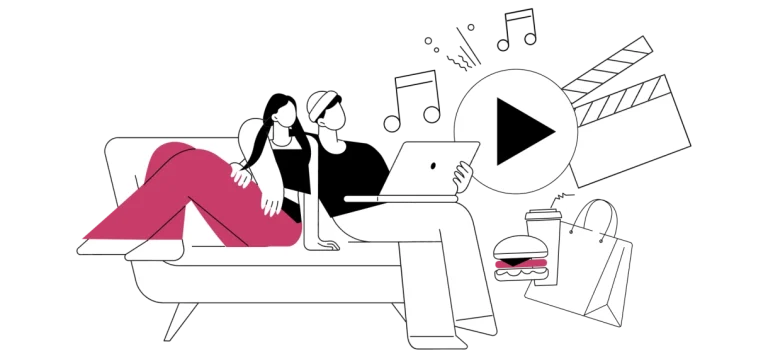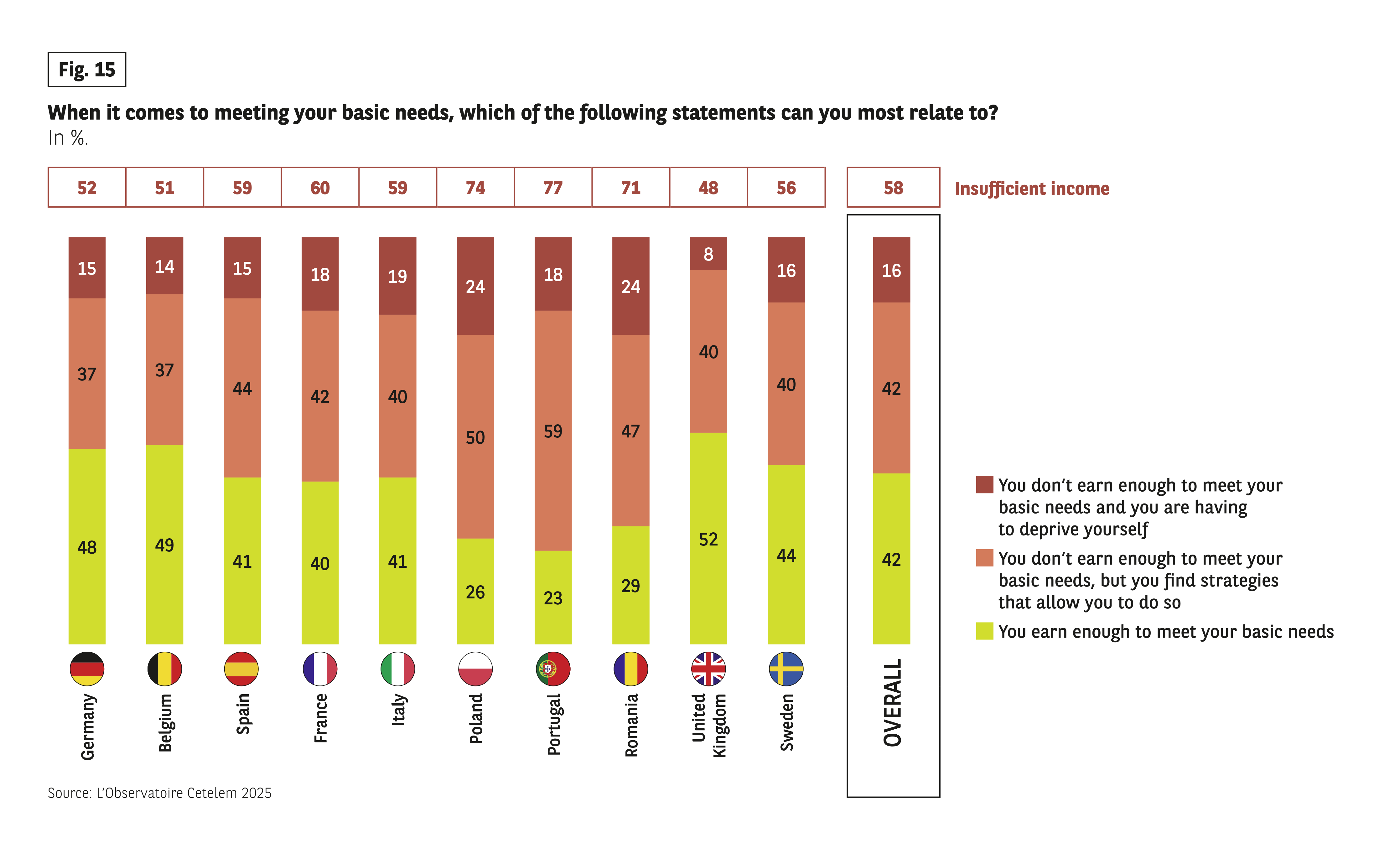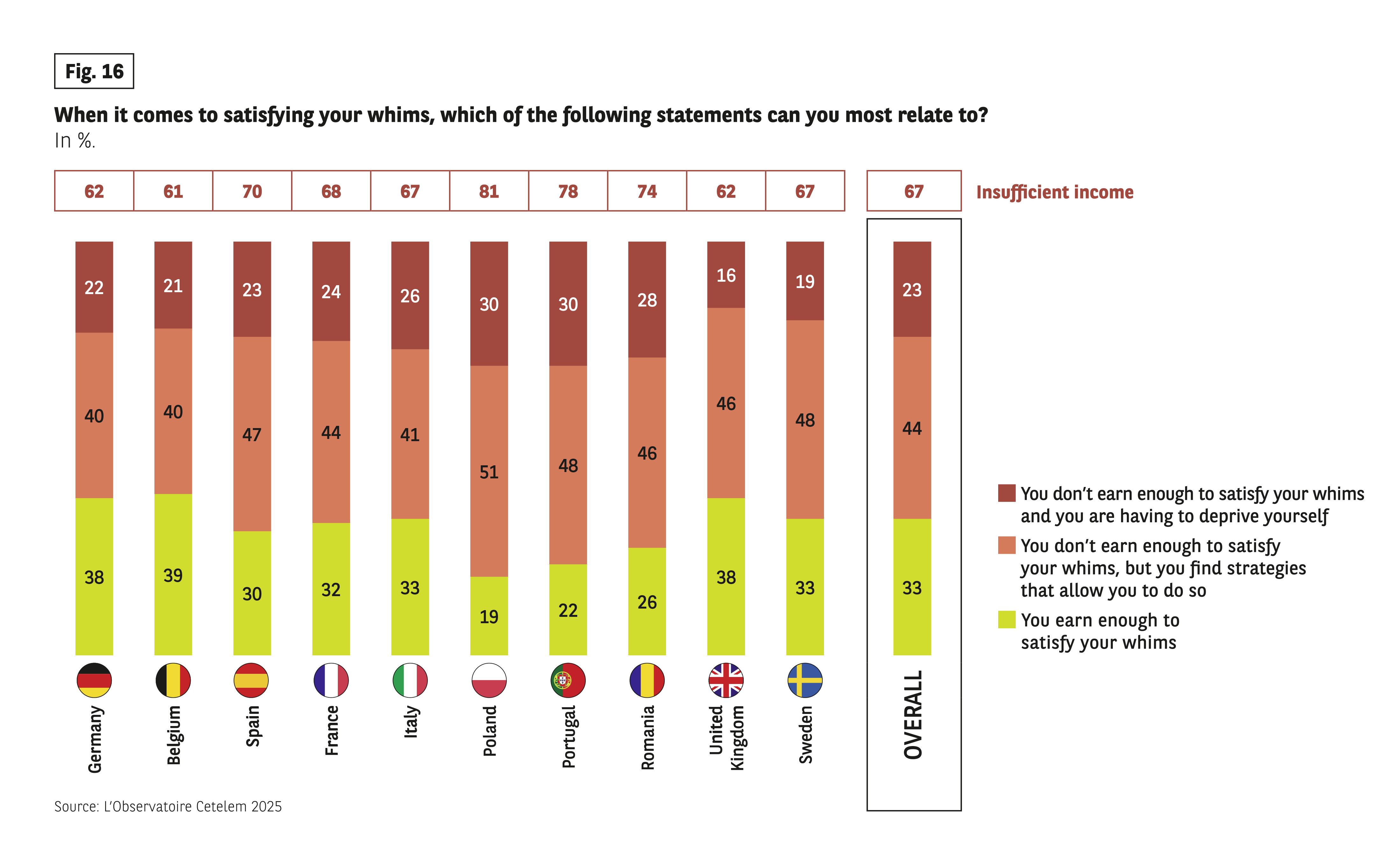Inadequate incomes prevent unbridled consumption


These conflicting attitudes towards consumption, which encompass both negative views and the notions of enjoyment and comfort, not to mention feelings of pride and a sense of being able to closely manage one’s spending, cannot escape cold, hard economic reality. Faced with the latter, Europeans feel that they can’t always afford what they would like to buy. The result is a feeling of frustration, which sometimes leads people to give up on what they covet, although some attempt to get round this by using their savings or alternative strategies.
NEEDS THAT CANNOT BE MET BY THE RESOURCES AVAILABLE
Wanting to treat oneself is fine. As long as one can afford it. That is what a majority of Europeans believe. Nearly 6 out of 10 respondents feel that they cannot afford to consume as freely as they would like or that they have to adopt specific strategies to meet their needs (Fig. 15). The UK stands out as the only country in which a majority of people can afford to consume. Conversely, in Portugal, Poland and Romania, more than 7 out of 10 people mention these financial difficulties.
Looking at the different income brackets, those who earn the least are most likely to experience this problem, but those on high incomes in Eastern Europe are also affected, albeit to a lesser extent. The 50-64 age group and young people are on the same wavelength, although the latter have a greater tendency to use their imagination to overcome their financial limitations and satisfy their needs.
In France, 18% of respondents feel they cannot afford to meet their basic needs, which is almost identical to the proportion of people who live below the poverty line.
Fig 15 – Feeling of sufficient or insufficient income to meet one’s needs
Download this infographic for your presentations Distribution by country between adequate income, insufficient income requiring strategies, or insufficient income leading to deprivation
Distribution by country between adequate income, insufficient income requiring strategies, or insufficient income leading to deprivation
UNFULFILLED DESIRES
The ability to satisfy one’s consumerist urges is even more likely to be affected by the issue of affordability. On this question, almost 7 out of 10 people state that their financial resources are insufficient. And if we look at the detail, we can see that the same countries, the same social categories and the same generations are confronted with thischallenge (Fig. 16).
Fig 16 – Feeling of sufficient income to satisfy one’s desires
Download this infographic for your presentations Question: “To satisfy your cravings, which of the following statements do you feel closest to?
Categories:
• Sufficient income
• Insufficient income but strategies
• Insufficient income leading to deprivation
Data (sufficient / strategies / deprivations):
• Germany: 38 / 40 / 22
• Belgium: 39 / 40 / 21
• Spain: 30 / 47 / 23
• France: 32 / 44 / 24
• Italy: 33 / 41 / 26
• Poland: 19 / 51 / 30
• Portugal: 22 / 48 / 30
• Romania: 26 / 46 / 28
• United Kingdom: 38 / 46 / 16
• Sweden: 33 / 48 / 19
• Set: 33 / 44 / 23
Source: The Cetelem 2025 Observatory.
Question: “To satisfy your cravings, which of the following statements do you feel closest to?
Categories:
• Sufficient income
• Insufficient income but strategies
• Insufficient income leading to deprivation
Data (sufficient / strategies / deprivations):
• Germany: 38 / 40 / 22
• Belgium: 39 / 40 / 21
• Spain: 30 / 47 / 23
• France: 32 / 44 / 24
• Italy: 33 / 41 / 26
• Poland: 19 / 51 / 30
• Portugal: 22 / 48 / 30
• Romania: 26 / 46 / 28
• United Kingdom: 38 / 46 / 16
• Sweden: 33 / 48 / 19
• Set: 33 / 44 / 23
Source: The Cetelem 2025 Observatory.
